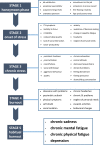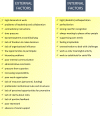Burnout in Healthcare Workers: Prevalence, Impact and Preventative Strategies
- PMID: 33149664
- PMCID: PMC7604257
- DOI: 10.2147/LRA.S240564
Burnout in Healthcare Workers: Prevalence, Impact and Preventative Strategies
Abstract
Approximately, one in three physicians is experiencing burnout at any given time. This may not only interfere with own wellbeing but also with the quality of delivered care. This narrative review discusses several aspects of the burnout syndrome: prevalence, symptoms, etiopathogenesis, diagnosis, impact, and strategies on how to deal with the problem.
Keywords: burnout; healthcare worker; impact; prevalence; prevention; symptoms.
© 2020 De Hert.
Conflict of interest statement
The author reports no conflicts of interest in this work.
Figures







Similar articles
-
Conceptualisation of job-related wellbeing, stress and burnout among healthcare workers in rural Ethiopia: a qualitative study.BMC Health Serv Res. 2017 Jun 19;17(1):412. doi: 10.1186/s12913-017-2370-5. BMC Health Serv Res. 2017. PMID: 28629360 Free PMC article.
-
Burnout in United States Healthcare Professionals: A Narrative Review.Cureus. 2018 Dec 4;10(12):e3681. doi: 10.7759/cureus.3681. Cureus. 2018. PMID: 30761233 Free PMC article. Review.
-
Burnout, mental health, physical symptoms, and coping behaviors in healthcare workers in Belize amidst COVID-19 pandemic: A nationwide cross-sectional study.Int J Soc Psychiatry. 2023 Jun;69(4):1033-1042. doi: 10.1177/00207640231152209. Epub 2023 Feb 6. Int J Soc Psychiatry. 2023. PMID: 36748178 Free PMC article.
-
Burnout among French pediatric healthcare workers during the COVID-19 pandemic.Psychol Health Med. 2023 Jul-Dec;28(7):1901-1915. doi: 10.1080/13548506.2023.2216465. Epub 2023 May 22. Psychol Health Med. 2023. PMID: 37218152
-
The Global Prevalence and Associated Factors of Burnout among Emergency Department Healthcare Workers and the Impact of the COVID-19 Pandemic: A Systematic Review and Meta-Analysis.Healthcare (Basel). 2023 Aug 7;11(15):2220. doi: 10.3390/healthcare11152220. Healthcare (Basel). 2023. PMID: 37570460 Free PMC article. Review.
Cited by
-
Burnout and Stress in Forensic Science Jobs: A Systematic Review.Healthcare (Basel). 2024 Oct 12;12(20):2032. doi: 10.3390/healthcare12202032. Healthcare (Basel). 2024. PMID: 39451448 Free PMC article. Review.
-
#WhyIDoIt: A Multidisciplinary Wellness Initiative in an Academic Emergency Department.West J Emerg Med. 2022 Aug 10;23(5):693-697. doi: 10.5811/westjem.2022.4.55813. West J Emerg Med. 2022. PMID: 36205660 Free PMC article.
-
'We are not here to enforce; we are here for the people' Factors influencing performance of contact tracing during the COVID-19 pandemic: A qualitative study.J Public Health Res. 2023 Nov 24;12(4):22799036231208325. doi: 10.1177/22799036231208325. eCollection 2023 Oct. J Public Health Res. 2023. PMID: 38020218 Free PMC article.
-
Does Organizational Commitment to Mental Health Affect Team Processes? A Longitudinal Study.J Healthc Leadersh. 2023 Nov 23;15:339-353. doi: 10.2147/JHL.S429232. eCollection 2023. J Healthc Leadersh. 2023. PMID: 38020722 Free PMC article.
-
Prevalence of burnout among German radiologists: a call to action.Eur Radiol. 2024 Sep;34(9):5588-5594. doi: 10.1007/s00330-024-10627-5. Epub 2024 Feb 12. Eur Radiol. 2024. PMID: 38345608 Free PMC article.
References
-
- Freudenberger HJ. The staff burn-out syndrome in alternative institutions. Psychotherapy. 1975;12:73–82.
-
- Freudenberger HJ. Burn-out: occupational hazard of the child care worker. Child Care Q. 1977;6:90–99. doi:10.1007/BF01554695 - DOI
-
- Maslach C, Jackson S. The measurement of experienced burnout. J Occup Behav. 1981;2:99–113. doi:10.1002/job.4030020205 - DOI
-
- Leiter MP, Schaufeli WB. Consistency of the burnout construct across occupations. Anxiety Stress Coping. 1996;9:229–243. doi:10.1080/10615809608249404 - DOI
Publication types
LinkOut - more resources
Full Text Sources

